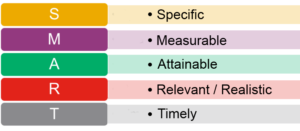Having a goal can be the first step towards achieving excellence. It can also help you deal with adversity and keep you focused. Here’s some thoughts on developing specific goals and making sure the goals are realized.
First consider what it is that you want to achieve, and then commit to it. Set SMART goals that motivate you then write them down to help make yourself accountable to them.
SMART Goals

A useful way of making goals more powerful is to use the SMART mnemonic (using weight loss for examples):
-
- S – Specific – What EXACTLY do you want to achieve? The more specific your description, the more likely you will achieve your goal. S.M.A.R.T. goal setting recognizes the difference between “I want to lose weight,” and “I want to lose 21 pounds before April 1st.”
- M – Measurable – Measurable means that you identify precisely what you will see, hear, and feel when you achieve your goal. It means breaking your goal down into measurable elements. You need objective evidence of progress. Being happy with your progress isn’t evidence. Lowering your intake of sugar is evidence. Eliminating processed food and eating healthy, fresh food is evidence.
- A – Attainable – Is your goal attainable? Answering that question requires you to investigate what it will take to achieve your goal. You weigh time, effort, and cost it will take to achieve your goal against the benefit of achieving your goal.
- R – Relevant and Realistic – Do you want to lose weight because YOU want to lose weight or because “everyone” says you should lose weight? If the goal isn’t relevant, if you aren’t doing a goal for YOU, you will likely fail. Is your goal realistic? Can you realistically achieve your goal? A goal of losing 60-pounds in 60-days sounds impressive – but losing a pound each day is unsustainable and unhealthy – so probably not realistic.
- T – Timely – A goal should be grounded within a time frame. With no time frame tied to a goal, there’s no sense of urgency. If you want to lose 10 lbs., when do you want to lose it by? “Someday” won’t work. To get your subconscious mind working on the goal, anchor the goal within a time-frame – “by April 1st.”
Continuing to use weight-loss as the example, instead of having “I want to lose weight” as a goal, it’s more powerful to use a SMART goal – “On April 1st, I will feel stronger and more full of energy at XX lbs. by counting calories, eating smaller, healthier portions and by working out for a minimum of XX minutes four times a week.”
Define the Steps to Your Goal
 A goal without a plan is just a dreamy wish. After you have your goal, form a plan and commit to the steps to achieve your goal. Your plan may have a single step, or it may have multiple steps in the case of more complex goals. In any case, write the steps down and cross them off as you achieve each step.
A goal without a plan is just a dreamy wish. After you have your goal, form a plan and commit to the steps to achieve your goal. Your plan may have a single step, or it may have multiple steps in the case of more complex goals. In any case, write the steps down and cross them off as you achieve each step.
Athletic Goals
As your thoughts turn from a weight-loss goal to your athletic goals, there are a couple things to consider.
There are three basic types of athletic goals:
Outcome Goals – Outcome goals revolve around a specific outcome – “I will win a National Championship.” The problem with Outcome goals is you do not have control over everything that goes into an Outcome, for example, you have no control over who you will compete against. Outcome goals are best used as long-term goals with Process and Performance Goals used as intermediate steps.
Performance Goals – performance goals define a specific standard to be achieved. “I will complete a 140.6 triathlon in under 12-hours.” Performance goals are used to set a personal standard so aren’t subject to the performance of others. However, performance goals can still set you up for disappointment if not used in conjunction with process goals. If your goal is to complete a 140.6 in under 12-hours, what happens if the weather is extremely hot and humid? What if there are thunderstorms and heavy rain? There can still be factors outside your control.
Process Goals – process goals deal with the technique or strategy necessary to perform well. You have complete control over process goals. Examples of process goals are:
- Remain aerobic during the swim
- Begin my nutrition plan within 10-minutes on the bike
- Maintain a 10:00/mile pace on the run
Process goals can help focus your attention and are very effective in helping to control race day anxiety.
Goal setting isn’t just about determining what you want to achieve but also how you will achieve it (process goals) and how you will measure the achievement (performance goals).
Hope that helps a little bit as you begin to consider goals for the upcoming season.
